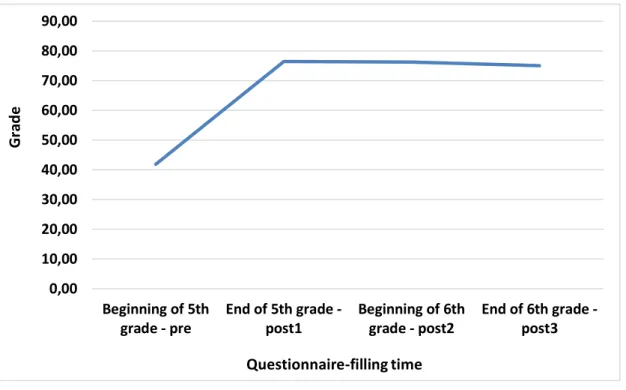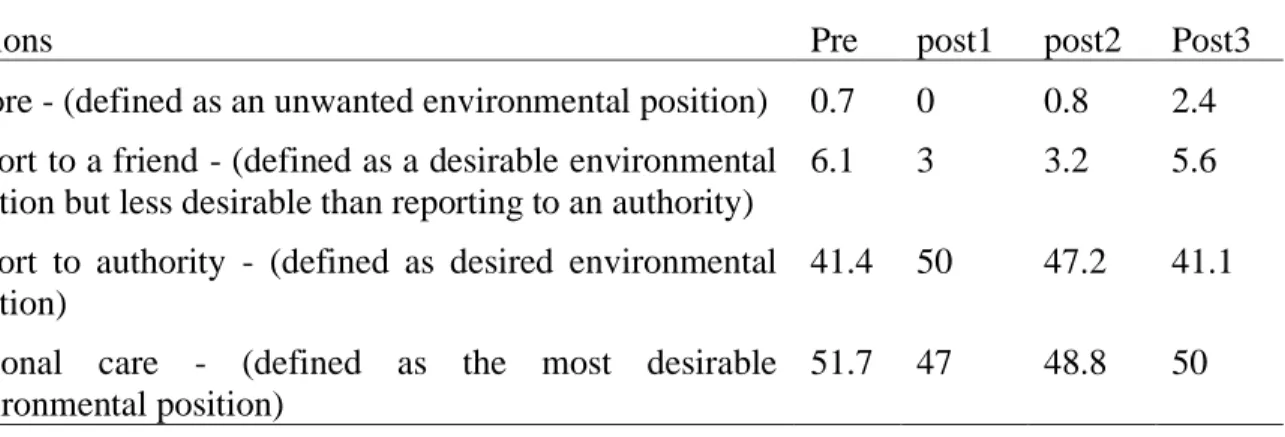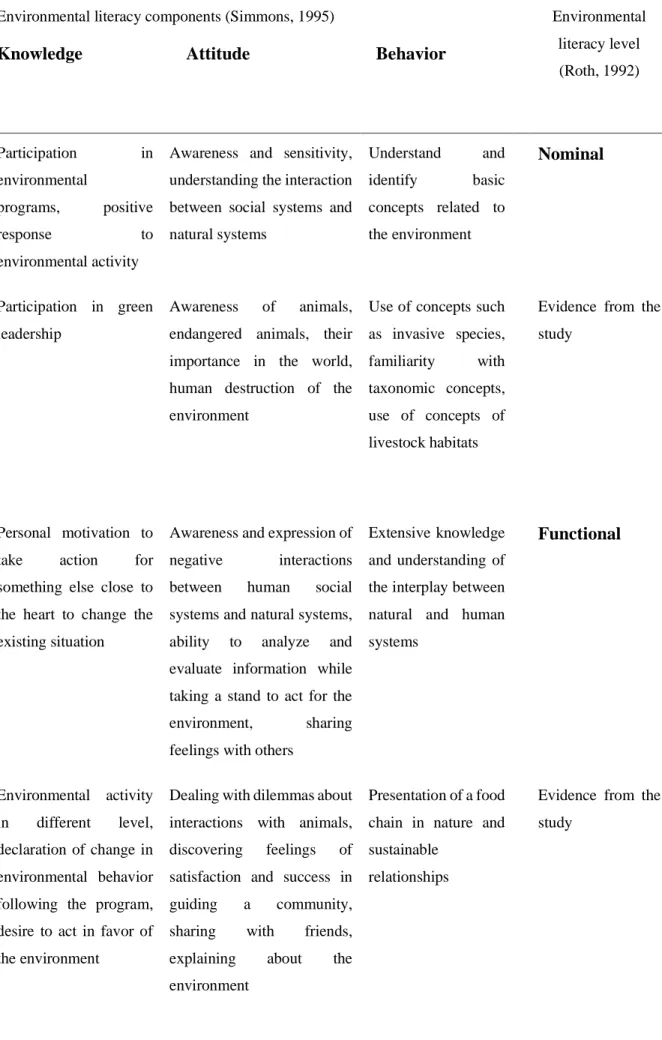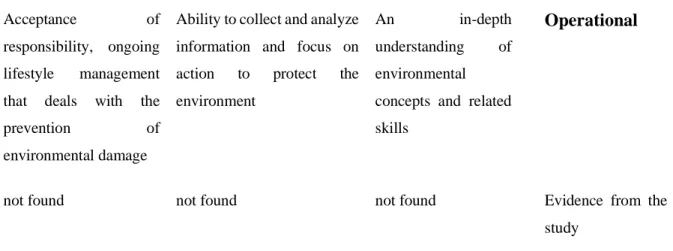Vol. 10, No. 2, 2020 pp. 5-17 http://doi.org/10.24368/jates.v10i2.166 13 5
http://jates.org
Journal of Applied
Technical and Educational Sciences jATES
ISSN 2560-5429
The contribution of the Lesser Kestrel to environmental literacy
Adiv Gal
Kibbutzim College of Education Technology and the Arts, 149 Namir Street, Tel Aviv 6250769, Israel, 972-52- 5298899, adiv.gal@smkb.ac.il
Abstract
Since 1996, fifth-grade students from the Alona School in the north of Israel have been leading “The Lesser-Kestrel” environmental education program designed to promote environmental literacy as well as the conservation of this endangered raptor. Therefore, the goal of this study was to examine the environmental literacy of fifth-grade pupils after one, two and three years. The study was based on quantitative questionnaires from 147 pupils completed during and after the program and also interviews with 6 of those pupils who had completed the program in the past. Pupils filled out the questionnaire at four different points of time throughout their educational program: prior to their studies in the environmental program, at the end of their studies in the program, about four months following their studies in the program and about one year after the completing of their studies. New research tools was used to evaluate the results included the Roth's level of environmental literacy combined with Simmons' components. The findings indicate that even three years after graduating, the pupils achieved a functional level of environmental literacy in all three components of these. In conclusion, it seems appropriate to promote long-term environmental educational programs that help retain environmental literacy for at least three years.
Keywords: environmental literacy; Lesser Kestrel; elementary school
Introduction
The Lesser Kestrel (LK) Program was established in 1996 by a bird watcher whose children went to Alona School in the north of Israel. She identified the decline of the LK population and was determined to make a difference. The bird watcher convinced the principal to commit to an Environmental Education (EE) program that would contribute to the protection of the LK.
They designed a student program emphasizing social, educational, and environmental values.
Since then, the program has been helping to protect the lesser kestrel population that has been nesting in the school and in the surrounding area.
Theoretical framework
The concept of environmental literacy (EL) was first coined by John Roth (Roth, 1968). Roth defined EL as the ability to understand and interpret environmental problems and to act for change or conservation of environmental systems (Roth, 1992). Since Roth's first publication of his definition of the concept, the various uses and interpretations of it have varied. Roth himself claimed: "Unfortunately there became almost as many perceptions of the nature of environmental literacy as there were people who used the term" (Roth, 1992, p.7) or "Most had never read, or heard of, the original article and were not using modifications of it as a basis of their own concepts of the term" (Roth, 1992, p. 7). Today, the most widely accepted meaning of EL includes awareness of environmental concern and its associated problems, as well as the knowledge, skills and motivations to work towards current problem solving and prevention (McBride, Brewer, Berkowitz, & Borrie, 2013). For the purpose of this study, EL has been examined according to two EL constructs: Roth's level of environmental literacy (Roth, 1992).and Simmons's components of environmental literacy (Simmons, 1995).
2.1. Roth's level of environmental literacy
According to Roth, there are three levels of EL: Nominal – the level at which a person can easily identify how natural and human systems work and how they interact, including basic perceptions of conflict between nature and human; functional – the level at which a person has the ability to gather information, analyse and evaluate interactions based on evidence, values and ethics. These people not only retain their information, but share it with others along with their feelings about the subject; operational – the level at which a person has an in-depth knowledge of environmental issues and knows how to collect, analyse and choose alternatives while taking proactive measures to improve the environmental situation and create a healthier environment.
2.2. Simmons' components of environmental literacy
According to Simmons, there are seven EL components: emotions; ecological knowledge;
political social knowledge; knowledge of environmental issues; skills and action strategies;
locus of control and acceptance of personal responsibility; behaviour (Simmons, 1995). All
seven relate to three categories: environmental knowledge, environmental attitudes, and environmental behaviour.
Therefore, the purpose of the study was to examine the EL of pupils according to Roth's level combined with Simmons' components, one, two and three years after graduation from the Lesser Kestrel environmental education program.
Methodology
3.1. Research context - The Lesser Kestrel environmental education program
The program meets two hours a week as an extracurricular activity integrated into the school’s schedule. The program emphasizes values, beliefs, norms, knowledge, and skills related to local social and environmental challenges. Many of the classes engage in outdoor learning, allowing pupils to observe the LK as well as contributing to the local action plan of LK conservation including building nest boxes for them. One of the highlights of the program is “LK Day,” a ceremony held in late May when young LK first open their wings and prepare to leave the breeding colony at the school. As part of the event, fifth-grade pupils have guided over 1,500 visitors through the grounds and explain the plight of the endangered species.
3.2. Research population
147 fifth-grade pupils from 2012, 2013 and 2014 answered the quantitative questionnaires.
They filled out the questionnaire four times during their studies: at the beginning of the fifth grade before starting to study in the LK environmental education program (pre), at the end of the fifth grade – when they finished studying in the program (post1), at the beginning of the sixth grade, about four months after completing their studies in the environmental program (post2) and at the end of the sixth grade - about one year after graduation the environmental program (post3).
In addition, during 2015, six pupils were interviewed. Two of them, Ayla and Anya (pseudonyms) were in fifth grade LK program in 2012 and were in the first class to complete the questionnaire. Two of them, Adi and Arya (pseudonyms), were in the LK program in 2013 and were in the second class completing the questionnaires. Two others, Tammy and Guy (pseudonyms) were in the LK program in 2014 and were in the third class completing the questionnaires.
3.3. Research approach
The study was carried out using a mixed-method approach. The quantitative section included statistical analysis and the qualitative section used an interpretive-constructivist paradigm (Burrell & Morgan, 1994) as a lens to capture the subjective reality of former pupils of the LK environmental education program. The qualitative analysis in this study is a deductive study and focuses on identifying well-known concepts (Armat, Assarroudi, Rad, Sharifi, & Heydari, 2018) related to EL and include knowledge, environmental attitudes and behaviour.
3.4. Research tools
3.4.1. Questionnaire
The questionnaire had four sections, but only three are presented in this study. The questionnaire was designed to create a supplementary picture of the students' environmental literacy and each section of the questionnaire examined a different aspect of environmental literacy. Part I had 10 general knowledge closed questions about the LK. Part II examined environmental attitudes by describing a case study story in which pupils encounter a fallen LK nest with cats (predators of LK) circling around. Pupils had four options which were divided into desirable or undesirable environmental positions. A desirable or undesirable position was determined by conservation values and by what pupils learned about the importance of animals in the ecosystem. The positions were: ignore - defined as an unwanted environmental position;
report to a friend - defined as a desirable environmental position, but less desirable than reporting to an authority; report to an authority - defined as a desirable environmental position;
and a personal care - defined as the most desirable environmental position.Part III had 10 questions using a five-level Likert scale (1 - never 5 - always) regarding behavioural environmental aspects (in all four questionnaires, pre, post1, post2, post3, Alpha Cronbach was higher than 0.765).
3.4.2. Semi structure interview
This kind of interview enables exploration of certain topics with a defined protocol while allowing some flexibility. The flexibility allows the interviewer to deepen and clarify various issues that arise from the interviewee's answers while linking the topics he / she wishes to explore (Fossey, Harvey, Mcdermott, & Davidson, 2002). The pupils were asked about the LK
environmental education program, while pupil presented with different environmental situations, which are unrelated to the LK, and their reaction to these situations was examined.
Results
4.1. KnowledgeKnowledge significantly increased statistically (pre/post1, t = -18.04, P <0.0001) and remained fairly stable for a year when pupils were tested twice more (post2/post3, t = 0.752, P = 0.453) (Fig. 1). This means that knowledge was retained over time even though the pupils did not engage in programs related to the LK and did not have any additional lessons on the subject .
Figure 1. The change in pupil scores in the knowledge test conducted at four different time points.
In addition to the quantitative findings, there were qualitative results from the interviews showing that the knowledge level was retained for two years after the pupils finished their studying in the LK program (Table 1).
0,00 10,00 20,00 30,00 40,00 50,00 60,00 70,00 80,00 90,00
Beginning of 5th grade - pre
End of 5th grade - post1
Beginning of 6th grade - post2
End of 6th grade - post3
Grade
Questionnaire-filling time
Table 1. Examples of pupil quotes in the various classrooms indicate the level of knowledge Quotes from semi structure interview
Class
The Myna is an invasive species that does not originate from Israel and causes damage to the LK... In the food chain if one animal is missing then the whole chain breaks like vertebrae ... If the insects disappear from the world the flowers will not reproduce and if there are no flowers and plants then there will also be no air.
Sixth grade
We learnt that it's not good because he imprint the animal ... so it [animal] won't leave you and it's also not good because it can't live with animals like him around because it just won't know how to do things like they do…. I also learned a lot about how to protect the environment
Seven grade
I remember that we learnt that the LK needs open fields where they can find food such insects, they are biological exterminator, but the farmers use pesticides that kill the insects and then the LK can die because they are eating poison insects, it's harmful to the food chain Eight grade
In summary, their knowledge, especially ecological-based knowledge that the pupils acquired during the LK environmental education program was retained for a few years after they finished.
4.2. Environmental attitudes
The quantitative findings do not indicate a change in environmental attitudes in the desired way of treating offspring of LK that has fallen from the nest and is surrounded by cats (Table 2).
Five of the six youths expressed positive attitudes that addressed broader environmental issues than the LK conservation (Table 3).
Table 2. Distribution (%) of environmental attitudes in response to the way in which a nest of LK that fell from the nest and surrounded by cats should be treated
Post3 post2
post1 Pre
Options
2.4 0.8
0 0.7 Ignore - (defined as an unwanted environmental position)
5.6 3.2
3 6.1 Report to a friend - (defined as a desirable environmental position but less desirable than reporting to an authority)
41.1 47.2
50 41.4 Report to authority - (defined as desired environmental position)
50 48.8
47 51.7 Personal care - (defined as the most desirable environmental position)
Table 3. Examples of program's graduates' reference to environmental issues Examples of references to environmental issues from program graduates (using apostrophes (‘) is generally
not desirable) Quotes from semi structure interview Class
Because we are the next generation in this country; we have to educate children not to throw out bags, recycle and protect more
Sixth grade
Even if it's some kind of intruder I wouldn't kill it; I would try to help it, take it to a vet or something, but surely not kill
Seven grade
You do not throw out plastic bags, so you're thinking ahead, not just about the endangered LK's, but about other animals that can come and eat it ...
Eight grade
The change in pupils' attitudes toward the environment following the LK environmental educational program can be found in eighth-grade Anna's comments, "I think it made me see, animals, birds…nature differently than before; I appreciate it more and am more concerned and it's more of an issue. I am interested now." Anna's environmental awareness that changed as a result of the program. To summarize this section, only the qualitative analysis helps to identify the differences in pupils' attitudes, and the development of their positive attitudes towards the environment following the program .
4.3. Environmental behaviour
The results of the quantitative test indicate that there was no significant statistical difference between environmental behaviour score from before to after the fifth grade program (pre/post1, t = -0.396, p = 0.693). The greatest score of environmental behaviour was observed at the end of the sixth grade (post3, 3.47) and was statistically significantly higher than all other tests, pre, Post1, and Post2 (p<0.007). In this case, too, the qualitative analysis adds interesting perspectives about the environmental behaviour (Table 4), which provide insight into the environmental literacy of the students based on the qualitative scale.
Table 4. Quotes of pupils of different ages relating to environmental behaviour Quotes from semi structure interview
Class
There is also a green leadership here that I am in… If I had the opportunity to go to the anti-devastation protests in the area, I would not have been like that before the LK program.
Sixth grade
When people litter I do reprimand them and I pick up the trash myself... I don't remember doing it before the LK program
Seven grade
Following the program, I also tell my friends, in a nice way, don't litter, pick up the trash.
Eight grade
Contrary to most pupils, Ayala, claimed "the program didn't contribute anything to me" and criticized the attempt to encourage environmental action among the pupils…" She also added
"What I do remember about the LK is that we were told not to do things alone [to help the falcon], because we don't know how, and we might just do more harm." It is evident that Ayla was frustrated by the teachers' reluctance to trust the pupils' ability to work for the LK. In conclusion, it can be said that the environmental program encourage pupils to pro- environmental behaviour initiate environmental activity at various levels, in the private sphere and the desire to act in the public sphere.
The findings in the study suggest that pupils have reached the second level of Roth's EL - functional level. At this level, there is evidence for all of the components of Simmons' EL components (Table 5).
Table 5. Findings of the study according to Roth's EL level and Simmons's EL components.
Environmental literacy level (Roth, 1992) Environmental literacy components (Simmons, 1995)
Knowledge Attitude Behavior
Nominal
Understand and identify basic concepts related to the environment Awareness and sensitivity,
understanding the interaction between social systems and natural systems
Participation in environmental
programs, positive
response to
environmental activity
Evidence from the study
Use of concepts such as invasive species, familiarity with taxonomic concepts, use of concepts of livestock habitats Awareness of animals,
endangered animals, their importance in the world, human destruction of the environment
Participation in green leadership
Functional
Extensive knowledge and understanding of the interplay between natural and human systems
Awareness and expression of negative interactions between human social systems and natural systems, ability to analyze and evaluate information while taking a stand to act for the environment, sharing feelings with others
Personal motivation to take action for something else close to the heart to change the existing situation
Evidence from the study
Presentation of a food chain in nature and sustainable
relationships Dealing with dilemmas about
interactions with animals, discovering feelings of satisfaction and success in guiding a community, sharing with friends, explaining about the environment
Environmental activity in different level, declaration of change in environmental behavior following the program, desire to act in favor of the environment
Operational
An in-depth
understanding of environmental concepts and related skills
Ability to collect and analyze information and focus on action to protect the environment
Acceptance of
responsibility, ongoing lifestyle management that deals with the
prevention of
environmental damage
Evidence from the study
not found not found
not found
Despite it being a deductive analysis, another theme was raised by the pupils. They expressed very positive emotions regarding the LK environmental program (Table 6).
Table 6. Quotes of pupils relating to emotion regarding LK environmental program Quotes from semi structure interview
Class
It's something different ... you don't spend all those hours in the classroom doing nothing, you go on observations, build nest boxes, guide ... it's really nice and teaches
Sixth grade
I remember we had tours and also went to explain to people ... it was really fun
Seven grade
…and something else that I loved was that we were allowed to do everything by ourselves. For example, they let us gauge the heat at a certain point in the school to figure out where to place the nest boxes
Eight grade
Even Ayala, who had complained about the LK environmental program, praised the training activity: "I remember everyone constantly wanted to guide, which is something I remember as a good experience, to make it clear to people, to show that we know, explain to 40-year-olds something they don't know about at all, that's a point I remember - it's a good memory." The first part of Ayala's words about the positive experience of acting for the LK by guiding, characterizes all the other five pupils' interviews from all grades.
Discussion and Conclusion
This study examined the EL of pupils during and one year, two years and three years after graduating from the LK environmental education program. Graduates of the program attested that the program was significant for their environmental literacy development. The study does not suggest a hierarchical relationship between environmental literacy components as is known from other studies (Kollmuss & Agyeman, 2002). The study suggests a new stem-and-flower model to understand the results based on the morphology of the Brassicaceae. The stem is the educational program. The receptacle is EL and the four petals match the four findings that emerged in this study: knowledge, attitudes, behavior and emotion. Biologically, the longer and wider the stem, the larger the flower will develop and its receptacle will be wider. This parallels the environmental programs as found in this study. This long-term environmental program that exposes pupils to a variety of environmental issues, created a broader receptacle - EL at a functional level (Roth, 1992) and "wider petals" - EL components: knowledge, attitude, behavior (Simmons, 1995) and emotion. Unlike the biology of most annual members of Brassicaceae, in the case of this study, it is evident that a "perennial plant" was created by this environmental program. This unique long-term environmental program (Gal & Gan, 2018) had an impact of at least three years on its graduates. Knowledge was retained, environmental attitudes were very positive, there was a desire to pro-environment behavior and positive emotions were presented in the context of the program.
The "flower of the Brassicaceae" created as a result of this educational program did not reach the highest level of EL which is “operational” level (Roth, 1992) in any of the three components of the EL (Simmons, 1995). While the attention of the teachers in the program could allow the operational level within the components of knowledge, attitudes, and pro-environmental behavior, pupils could not be expected to achieve the operational level. The reason for this is that Roth's article in the late 1960s (Roth, 1968) was based on independent adults, while this study is about pupils who are still under their parents' restrictive supervision.
In conclusion, the impact of a long-term environmental education program can be seen on the level of EL and its components, as well as various aspects of emotion, even three years after the program. Therefore, it seems more advisable to promote long-term educational programs that emphasize different aspects of the environment than to use short-term environmental programs that focus on a single subject.
References
Armat, R. M., Assarroudi, A., Rad, M., Sharifi, H., & Heydari, A. (2018). Inductive and deductive: Ambiguous labels in qualitative content analysis. The Qualitative Report, 23(1), 219–221.
Burrell, G., & Morgan, G. (1994). Sociological paradigms and organisational analysis:
Elements of the sociology of corporate life. Burlington,VT:Ashgate.
Fossey, E., Harvey, C., Mcdermott, F., & Davidson, L. (2002). Understanding and evaluating qualitative research. Australian and New Zealand Journal of Psychiatry, 36, 717–732.
Gal, A., & Gan, D. (2018). What went well? Understanding the culture of a long-term Israeli environmental education primary school program. Australian Journal of Environmental Education, 34(3), 262–289.
Kollmuss, A., & Agyeman, J. (2002). Mind the gap: Why do people act environmentally and what are the barriers to pro-environmental behavior? Environmental Education Research, 8(3), 239–260. https://doi.org/10.1080/1350462022014540
Roth, C. E. (1968). On the road to conservation. Massachusetts Audubon, 38 – 41.
Roth, C. E. (1992). Environmental Literacy: Its roots, evolution, and directims in the 1990s.
Columbus, OH: ERIC Clearinghouse for Science, Mathematics, and Environmental Education.
Simmons, D. (1995). Papers on the development of environmental education. American Association for Environmental Education, Troy, Ohio, USA.
Acknowledgments
I thank many members of the Alona School, including administrators, teachers, students, parents and staff for their involvement and assistance. I also want to thank Dr. Orna Falik and Mrs. Mital Vaknin for their support of this research and their contribution.
About Authors
Dr. Adiv Gal is a co-founder of the Israeli Institute for Environmental and Sustainability Education. He earned a Ph.D. in zoology Hebrew University, Jerusalem. Dr. Gal teaches a variety of courses at the undergraduate and master’s degree levels in the science department at
Kibbutzim College in the areas of environment and sustainability. He has led environmental education programs in Israel for more than twenty years and has also taught in elementary schools for the past twelve years. Recently, his research interests include studies of sustainability, self-efficacy for teaching sustainability, and sustainability and multiculturalism.



